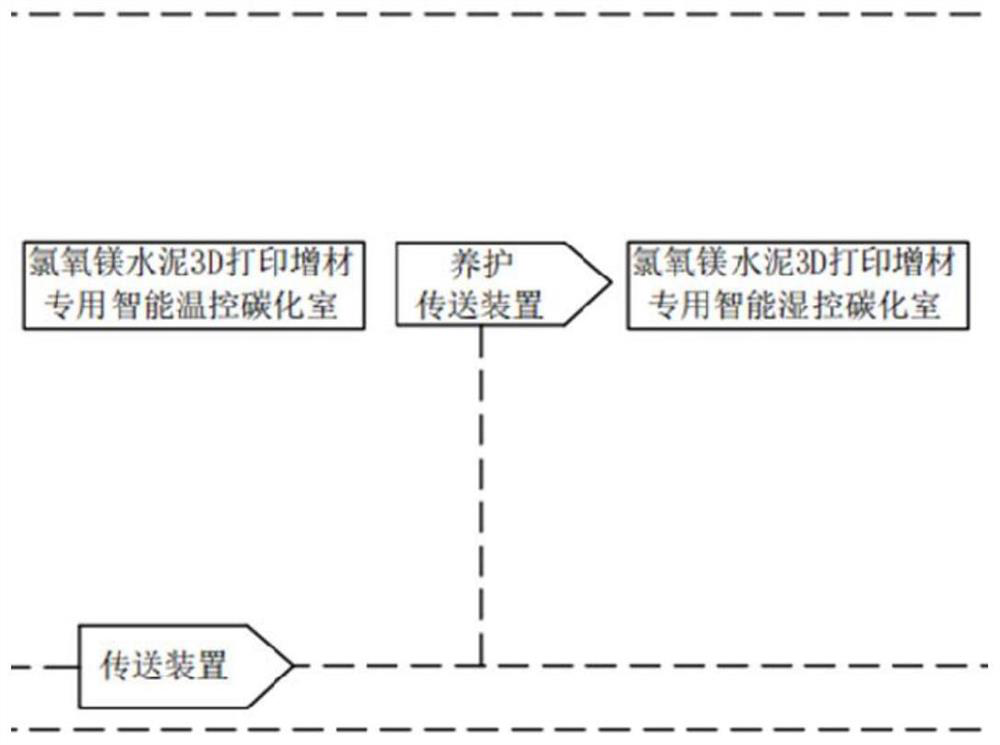Magnesium oxychloride cement additive for 3D printing and application thereof
A magnesium oxychloride cement and 3D printing technology, applied in the field of building materials, can solve the problems of lack of fresh magnesium oxychloride cement slurry cooling, low overall carbonation degree, etc., to improve the early microstructure and macroscopic performance, and solve the cooling technology Difficulty, effect of promoting exothermic reaction
- Summary
- Abstract
- Description
- Claims
- Application Information
AI Technical Summary
Problems solved by technology
Method used
Image
Examples
Embodiment 1
[0046] Example 1 The magnesium oxychloride cement additive for 3D printing, the ratio and test results of the magnesium oxychloride cement additive are shown in Table 1.
[0047] Table 1 Magnesium oxychloride cement additive ratio, test table 1
[0048]
[0049]Among them, the light-burned magnesia is an industrial-grade raw material, the content of magnesia is 97.2%, the content of active magnesia is 76.0%, the average particle size is 118nm, and the specific surface area is 51m 2 / g; the magnesium chloride hexahydrate is an industrial-grade raw material, the fineness is 48 μm, and the content of magnesium chloride hexahydrate is 44%; the anhydrous citric acid is chemically pure; the dry ice is rice grain-shaped, and the length is 5mm.
Embodiment 2
[0050] Example 2 Magnesium oxychloride cement additive for 3D printing, the ratio and test results of the magnesium oxychloride cement additive are shown in Table 2.
[0051] Table 2 Magnesium oxychloride cement additive ratio, test table 2
[0052]
[0053] Among them, the light-burned magnesia is an industrial-grade raw material, the content of magnesia is 97.2%, the content of active magnesia is 76.0%, the average particle size is 118nm, and the specific surface area is 51m 2 / g; the magnesium chloride hexahydrate is an industrial-grade raw material with a fineness of 75 μm, and the content of magnesium chloride hexahydrate is 46%; the anhydrous sodium carbonate is pure for chemical analysis; the dry ice is rice-shaped and has a length of 15 mm.
Embodiment 3
[0054] Example 3 Magnesium oxychloride cement additive for 3D printing, the ratio and test of the magnesium oxychloride cement additive are shown in Table 3.
[0055] Table 3 Magnesium Oxychloride Cement Additive Ratio, Test Table 3
[0056]
[0057] The light-burned magnesia content is 93.8%, the active magnesia content is 66.2%, the average particle diameter is 190nm, and the specific surface area is 32m 2 / g; the magnesium chloride hexahydrate is an industrial-grade raw material with a fineness of 55 μm, and the content of magnesium chloride hexahydrate is 45%; the borax is pure for chemical analysis; the dry ice is rice-shaped and has a length of 10 mm.
PUM
| Property | Measurement | Unit |
|---|---|---|
| particle size | aaaaa | aaaaa |
| specific surface area | aaaaa | aaaaa |
| length | aaaaa | aaaaa |
Abstract
Description
Claims
Application Information
 Login to View More
Login to View More - R&D
- Intellectual Property
- Life Sciences
- Materials
- Tech Scout
- Unparalleled Data Quality
- Higher Quality Content
- 60% Fewer Hallucinations
Browse by: Latest US Patents, China's latest patents, Technical Efficacy Thesaurus, Application Domain, Technology Topic, Popular Technical Reports.
© 2025 PatSnap. All rights reserved.Legal|Privacy policy|Modern Slavery Act Transparency Statement|Sitemap|About US| Contact US: help@patsnap.com



